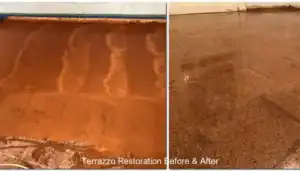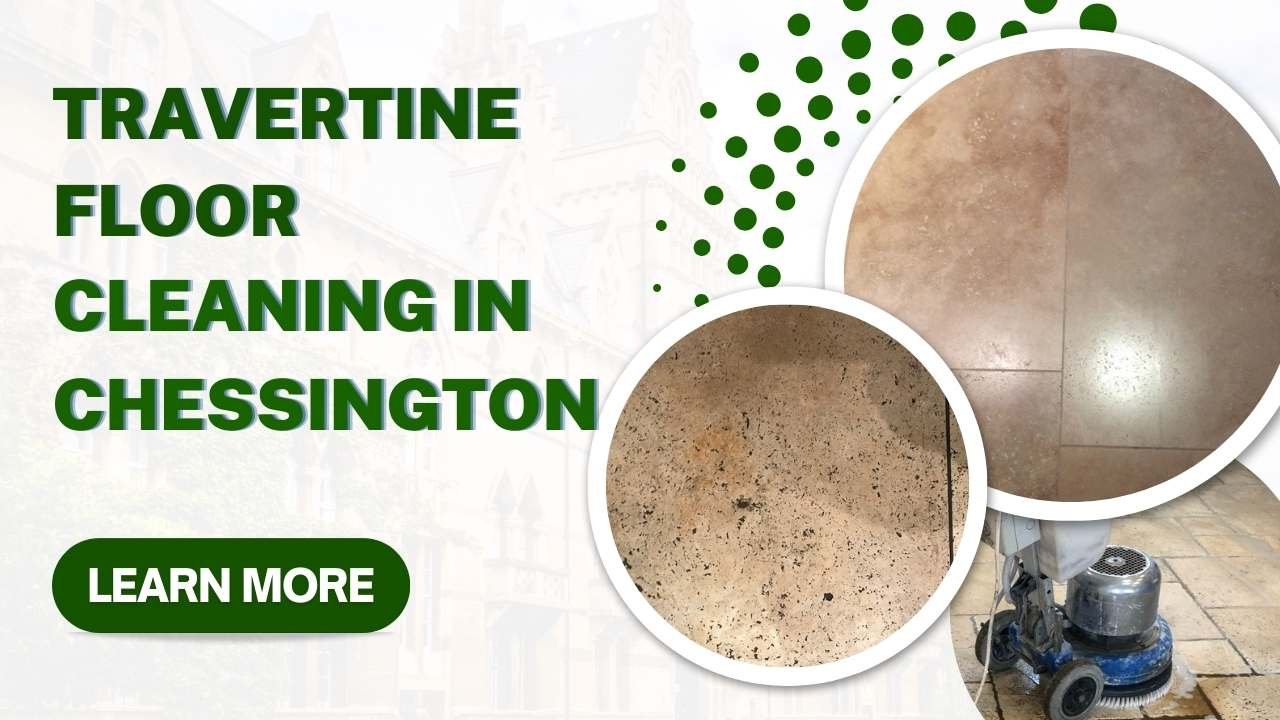


28 August 2024 by
sitemanager
This case study highlights the restoration of travertine tiles in high-traffic areas of a property in Chessington, Surrey. Over time, the travertine had become dull, stained, and worn, requiring professional intervention. The project involved deep cleaning, filling natural holes, and applying a protective sealant. The outcome was a revitalized, low-maintenance floor that restored the natural beauty of the travertine while ensuring long-term protection.
This Travertine Floor Cleaning In Chessington project arose because the homeowner wanted to restore the travertine tiles in their kitchen, hallway, and w/c. These high-traffic areas had seen significant wear over the years, and the client wanted a clean, durable floor that would showcase the natural colours of the travertine while being easy to maintain.
The travertine tiles, known for their natural beauty and durability, had been installed over a decade ago. However, the tiles had lost their smooth finish, and ingrained soil had collected in the pits and voids. The grout had also become soiled, detracting from the floor’s appearance. The project scope included deep cleaning the tiles, filling natural holes, and applying a protective sealer to ensure the floor’s long-term durability and aesthetics.
The key challenges faced during this project included:
An initial assessment revealed the extent of the soiling and wear on the travertine tiles. A plan was developed to address the ingrained soil, fill the natural holes, and apply a protective sealer to enhance the tiles’ durability.

The cleaning process began by preparing the work area—removing small furniture items and clearing loose debris through brushing and vacuuming. We applied a diluted travertine cleaner and left it to soak for ten minutes. Then, we used a rotary scrubbing machine with a medium-grade scrubbing brush. The scrubbing removed the surface soil, but some remained in the holes and pits. So, we used our hot-water rinse and capture equipment to lift the soils from these holes.
After cleaning, we used coloured grout to fill the holes and gaps in the grout. This step was crucial to enhancing the floor’s appearance and preventing further damage. The process involved careful attention to the grout lines to ensure a smooth, slightly concave surface that would resist future soil collection.

We applied a hybrid satin finish film-forming sealer using a roller to provide a mid-sheen look. This sealing process acted as a protective barrier against stains and dirt, ensuring the floor would be easier to maintain moving forward. We completed the sealing carefully to provide full coverage and a consistent finish.
The entire project took two days to complete, from assessment to completion.
We restored the travertine to its original finish, removing the ingrained soil and stains and bringing back the natural colours of the tiles. The client expressed her delight with the results, noting that the floor looked as good as new. The protective sealer ensures the travertine remains low-maintenance and durable, providing long-term beauty and functionality. The project transformed a dull, worn floor into a stunning, revitalized surface.
This travertine cleaning project in Chessington restored the natural beauty of the tiles, ensuring they would continue to be a durable and low-maintenance flooring solution for the homeowner. Combining deep cleaning, careful filling, and strategic sealing provided a comprehensive solution that enhanced the floor’s appearance and longevity. This case study underscores the importance of professional cleaning and maintenance for natural stone surfaces like travertine.
If you have a travertine floor that needs cleaning or restoration, contact us today for a consultation. Our professional services will ensure your natural stone surfaces remain beautiful and functional for years.
The entire travertine cleaning process typically takes several hours, depending on the floor’s condition. Effective cleaning techniques enhance floor maintenance, thoroughly removing ingrained soil and preparing for sealing to prolong tile longevity.
Using homemade solutions on travertine can be risky due to potential chemical reactions that may damage the stone. It is advisable to opt for pH-balanced cleaners specifically designed for natural stone to guarantee safe and effective cleaning.
Travertine floors can be installed over existing tiles. Proper installation methods, including assessment of the underlying surface and potential levelling, are essential to achieving a stable, long-lasting finish.
The cost range for travertine floor cleaning services varies based on several factors. The cleaning methods employed, the extent of soil removal required, and the condition of the tiles. It typically falls between £3 and £5 per square foot.
Frequency recommendations suggest professional cleaning of travertine floors every 12 to 18 months. Regular maintenance tips include prompt spill management and periodic sealing. These will preserve the natural beauty and longevity of the stone surfaces.